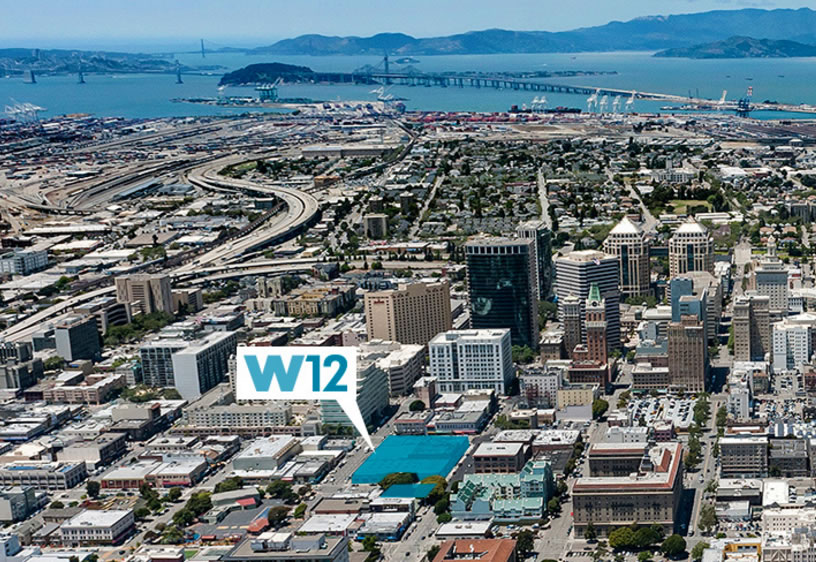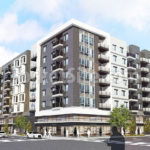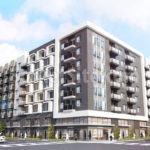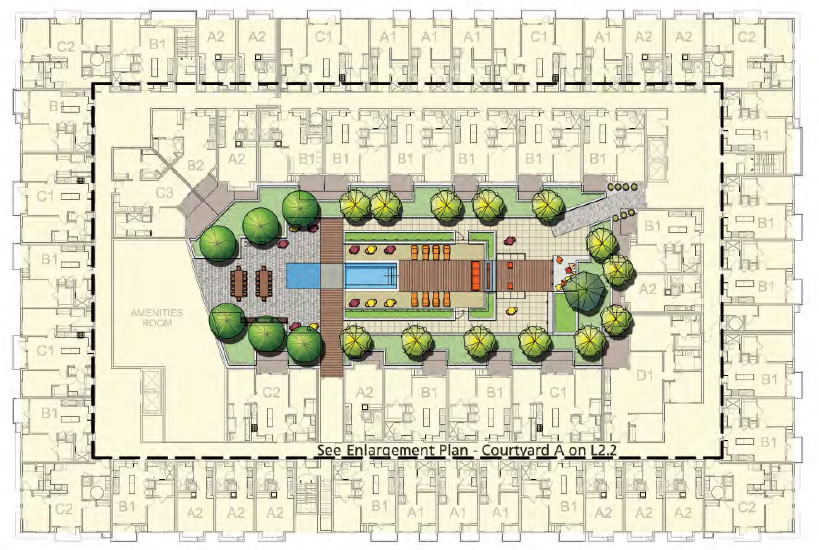Plans for 339 apartments to rise up to seven stories in height across the downtown Oakland block bound by Webster, Harrison, 12th and 11th Streets, and for 77 units across the street on the quarter block parcel at the corner of 12th and Harrison, have been submitted to the city’s Planning Department and are now officially under review.
In addition to the 416 apartments, the development as proposed by The Martin Group and designed by VTBS Architects includes 324 parking spaces and over 26,000 square feet of ground floor commercial space, with an 8,000-square-foot market at the corner of Harrison and 12th as envisioned.
A private courtyard includes a spa and outdoor space for residents.
While the “W12” site, which includes the 301 12th Street and 285 12th street parcels, is zoned for significantly more height and was marketed last year with conceptual plans for two towers to rise up to 265 feet, neither of the proposed buildings would rise above 83 feet as drafted.
And having been designated an “Opportunity Site” within Oakland’s Lake Merritt Station Area Plan, the approval process for the development as proposed will be streamlined and expedited.





While I wish they would build this higher, this isnt bad and will support infill and better density than what exists now….that part of downtown could use many of these type of buildings ASAP, but hopefully we will still see some large towers go in south of 13th st down toward the 880 / from Broadway to Lake merrit bart.
Terrible underutiilzation, and Right Near Freaking BART. This is a crime. How many units could you have if it were 15 or 20 stories on this huge site? Such a missed opportunity. Wonder if it was earlier in the cycle they’d take a bigger chance.
I’d also prefer a high-rise, but until we have a giant 3D robot that autonomously prints skyscrapers from raw steel…
I think Trump is working on that for his second term as President, it will be used on buildings once it finishes the wall.
i think this is appropriately scaled — if you build it 3x or 4x this height, then you won’t get additional projects nearby. it’s more important that lots of under-performing lots are upgraded to mid-rise (5-10 stories), as opposed to a few under-performing lots upgraded to high-rise (15+ stories). there are so many under-performing, 1-story lots around downtown oakland — the vastness of it needs to be tackled.
in short :: lots of new mid-rises > a few new high-rises
But lots of high rises > lots of mid rises. I see no reason why, over time at least, the entirety of downtown Oak can’t be upzoned. Once this is built, this lot not going to be redeveloped for 100 years. I think your argument makes sense only if we know the pace of development, which is unknowable given cycles, local opposition, etc. I think prudent to get as many units built as possible as soon as possible.
A strategy focused on high-rises is not going to achieve affordability. Something the overly simplistic “build, build, build” crowd is oblivious too. Much like those who scream “supply! demand!” but who never made it past Chapter 1 in Econ 101.
Vancouver has been trying this strategy for years and its been an epic failure that’s only make what you otherwise be a nice, but otherwise unremarkable medium-sized Pacific Northwest city into one of the most unaffordable housing markets in North America, courtesy of having CREATED a previously unexacting market attractive to the great slush funds of domestic and foreign capital looking to park capital in high rise condo units.
High-rise buildings, by and large, do not age in the way low-rise and mid-rise construction does – and generally does not become “naturally affordable” over time in the way that 3-7 story buildings do. They also take an exceedingly longer time to finance and construct, have a higher risk premium attached to them, and thus you never see enough being built to meet local demand. And this is without even getting into issues of market segmentation and that the fact that building lots of luxury units in the sky has been shown by economists to have limited effect on affordability lower down the price scale.
On the other hand, building lots of wood-frame, 3-7 story buildings, of varying quality levels, makes a lot more sense, if only that those type of buildings are (relative to high rise) far easier to finance, faster to build, and will over time “age” more, with more opportunity to become more affordable over time to middle class households.
I tend to like tall skyscrapers, and when we build one, always wish it were a bit taller. However I was just in Berlin and much of the city is a very dense 4-8 stories with taller buildings and skyscrapers at some intersections and roundels. It had a very nice urban feel that seems to be lacking in much of even San Francisco and Oakland but it certainly wasn’t Manhattan or Singapore. Somehow mid-rise zoning seems to be very family-centric too, in a way that highrises aren’t. That sounds like exactly what Oakland needs.
You’ll actually find that high-rise projects in Vancouver and suburbs are relatively affordable. Their building costs are far less than the Bay Area. The Vancouver housing crisis is really focused on extreme, intense foreign buyer competition for a finite supply of single family.
That is just wrong. We don’t measure affordability by looking at housing in one market and comparing it to median incomes in another market. Gauging the affordability of housing in Vancouver to the cost of housing in the Bay Area is just stupid – doubly stupid given that Vancouver housing prices are quoted in Canadian dollars.
Per the Royal Bank of Canada earlier this year: “It has never been so unaffordable to own a single detached home in the Vancouver area.” (RBC estimates that for a household with a 25-year mortgage and average income, it will take 109 per cent of their disposable cash to afford the full cost of owning a single, detached home, including mortgage, utilities and taxes.)
Housing in Vancouver is widely recognized as not only the most unaffordable in Canada, but in North America as a whole, in terms of the costs of housing in Vancouver compared to the median incomes in Vancouver.
Despite woolie’s incorrect statement about who buys Vanc’s high rises, what’s also wrong is your logic, which is essentially: If high rises didn’t work in Vancouver, then high rises cannot work anywhere.
Thank you for making my point for me by quoting a source on the affordability of detached single family homes.
“makes a lot more sense” – to you. Not to me. You are overestimating the percentage of ownership of foreign capital.
The aging/filtering argument strikes me as something that may have been historically true; not at all guaranteed going forward in a fast-growth region with a strong and diverse economic base. Given the publicly available tools/methods of opposition to building, given the timely need, I don’t see how there is an argument for not maximizing properties in already-dense districts next to Heavy Rail. Capitals for emphasis. This is a colossal asset for the region. There will be Zero filtering probably forever until the region becomes a not-prime economic engine. Good luck on that for decades.
You also generally seem to be arguing that more supply does not help. Then what does? Suspension of the rules of capitalism? The hand of God? I don’t think your position is logical at all.
Let me add that if we could wave a wand and create a Barcelona-like consistent low or mid rise density, I’d be great with that!! I just think that is a fantasy. Too many incumbents. You will not see SFH neighborhoods submitting to be converted to midrise streetwall apt buildings.
Barcelona is interesting in its core… While I love that city overall I found its modern core outside of the ancient gothic district felt way to master planned, repetitive, and boring. Even though it was quite urban and vibrant I didn’t much care for the urban design or acgirecture of the modern core. Paris and London seemed to naturally get the density outside of their hi rises that Barcelona tried to construct last century. I didn’t like it. Loved the city overall though.
I don’t argue that at all, if you bothered to take your bias filter off. But rather, that the mantra of “just building more”, regardless of building typology or price is over-simplified to the point of being wrong, as it completely ignores market segmentation, as well as the market-making effects of high rise construction.
So your over simplistic understanding of how supply and demand works in real estate markets is correct, but aging/filtering evidence of the past is not.
OK, sure…
Funny, I think your thinking is simplistic. I consider every single factor you list, have worked with real estate developers, public policy, etc. But perhaps your mind only sees one side of everything. Also I’m not addressing the Barcelona comment at you.
One example of your simple (IMO) thinking: e.g. that wealthy foreign investors somehow won’t buy a unit in a mid rise building, which is implicit since you say we shouldn’t build high rises partially because foreign investors buy too many units (BTW – I detest foreign investor ownership. Would love to somehow tax this out of existence. Don’t know a solution.)
And how about heavy rail and the utility of using a near parcel for a small building? The region paid billions for it. We can maximize the investment with density near stations, and lessen the demand on outlying areas. Yet you wave that away. So I believe you have a strange “filter” of your own re: infrastructure.
(HW) Your American bias is showing: as every Canadian can tell you, Vancouver is medium-sized Pacific SOUTHwest city.
While you are correct, many Vancouverites consider the region to be part of the Pacific Northwest.
Wood-frame, 3-7 story buildings, of varying quality levels…. will over time “age” more, with more opportunity to become affordable overtime… OR become dilapidated, dated housing to begin blighting the newly declining urban area as it enters the inevitable cyclical timeline.
Can’t wait to hear how he incentivizes builders to make those “varying quality levels”, instead of just maximizing profits and going luxury. Oh, but I’m sure he has it figured out, and I’m sure it’s politically realistic.
Just to put density in perspective — this is 416 units for a 1.7 acre site, or 245du/ac.
That isn’t much less than a typical high-rise, which have larger setback and tower separation requirements. In the meantime, a stick built project will be easier and faster to entitle, finance, and construct. A real world, completed project at 245du/ac is better than a hypothetical future project at 400du/ac.
(Not to mention there are currently at least a dozen high-rise proposals or entitled projects in central Oakland — of which none to my knowledge have permits issued.)
DU/AC = Dwelling units/Acre, not related to University of Delhi, which is what came up when I first Binged du/ac.
One other point: creating affordable housing is clearly very difficult, complex, and has a multiplicity of likely (if any) solutions, not one silver bullet solution (not a likely one, at least. E.g., eliminating local control over land use.)
One is not arguing in good faith if one says someone’s development is bad for affordability if the critic does not indicate their own proposed solution for affordability, and also balance that with the region’s needs. Not one’s own parochial needs. I.e., paraphrasing, “high rises in XYZ aren’t good for affordability” is a silly claim unless you indicate what a likely, real-world alternative is for getting units built, and if not, why is not getting units built better than getting units built? In the near term?
Its called building at mid-rise densities, of 3-7 stories, wood frame construction. So much derp, so little time.
Thank you, oh., derpmaster. Awaiting your command to demolish 100 square miles of existing homes, deport homeowners, disposess them of their abilities to protest, and then construct said structures. Onward!
You are a living example of why affordability advocates are so politically impotent.
Silly me – I forgot that the so-called Wonk has built in to his POV that more supply is not better. In that case, sure! Build 3 story midrise buildings! Because it’s certainly no better to build 10 stories, because, you know, complicated stuff that I can’t explain!
I see most wood frame condos and mid rises sheathed in OSB these days. Godawful stuff, once it gets damp it falls to pieces, much faster than plywood even. Does not bode well for long-term durability. The ones that don’t have an ace job at both the design AND execution of waterproofing will likely be tear-downs in three to five decades.
Tear-downs in 30-50 years? That’s good, by then the area will be up-zoned, and it means we won’t be stuck with low-rise buildings for 100 years.
Building going forward is mainly going to depend on ownership, design, platting, zoning regs (approval) so bulldozing single family owners seems fatuous unless there is a redevelopment project by the plutocrats.
Cheapest capital cost to develop seems to drive the scale of this project.
UPDATE: Local Coalition Challenges Redevelopment of a Chinatown Block